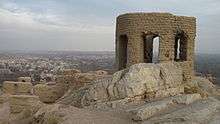Zoroastrianism
Zoroastrianism is an ancient Iranian monotheistic religion with a history spanning over 3,500 years, that survives to the present day. It was founded by Zoroaster, also known as Zarathrustra, though many of the traditions in the religion have roots that go back centuries earlier.
Understand
From 650 BC to 600 AD, Zoroastrianism was the dominant religion in Greater Persia and influenced both the Abrahamic religions to the west and the Indic religions to the east. Zoroastrianism gradually declined after the Islamic conquest of Persia in 651.
Today there are two main communities of Zoroastrians: the Parsis of India who fled and sought refuge in Gujarat once they became a minority and persecuted in Iran, and the Iranian Zoroastrians who have remained in Iran and Central Asia but continue to face discrimination and persecution. Many Zoroastrians have now emigrated and live in Western countries.
Cities and other destinations
Iran

- 🌍 Isfahan. An atashgah (fire temple), in the mountainous outskirts of Iran's former capital, offers a commanding view of the city.
- 🌍 Karaj. Takht-e Rostam, a stone built Parthian-era temple of fire is one of the main attractions here.
- 🌍 Ray. A 'tower of silence', in which the corpses were left to be decayed lest they contaminate holy earth and fire as per Zoroastrian beliefs, can be found in the city.
- 🌍 Takab. Takht-e Soleyman, an ancient Zoroastrian fire temple that is on the UNESCO World Heritage list, is nearby.
- 🌍 Yazd. Yazd has remained a relative Zoroastrian stronghold as the rest of Iran converted to Islam. Between 5 to 10% of the population are Zoroastrian. The fire temple of Yazd is believed to have been continually burning since the 5th century.
India
- 🌍 Mumbai. During British rule, many Parsis moved to the big city and became a part of the elite entrepreneurial and business class. Many of India's richest Parsi families, including the Tata and Wadia families, are based in Mumbai. The city is also full of Parsi cafés, a legacy of their cuisine and culture.
- 🌍 Sanjan. The landing point of the first wave of Parsi refugees in India and therefore the town with the oldest Zoroastrian presence in India. The Parsis named the town Sanjan after the its namesake in Greater Khorasan, now in Mary Province, Turkmenistan.
- 🌍 Udvada. The Udvada Atash Behram (fire temple) is the holiest in India and the oldest continually used fire temple in the world. It has become an important pilgrimage site for Zoroastrians all over the globe.
Azerbaijan
Azerbaijan derives its name from Atropatene, the Greek translation of an Old Persian word meaning "the Land of Holy Fire". As such, the country has a number of sites associated with Zoroastrianism.
- 🌍 Baku. In the northeast of Azerbaijan's capital is the Baku Ateshgah (Fire Temple). The castle-like structure combines Persian and Indian architectural styles, and has been a Zoroastrian, Hindu and Sikh pilgrimage site for centuries.
- 🌍 Khinalug. The locals of this very remote and isolated mountain village are unrelated to the majority of Azerbaijanis who are Turkic. Once a major centre of Zoroastrianism in the Caucasus, the locals converted to Islam in the 12th century and are now pious Muslims, although both the village and the surrounding countryside are very rich in Zoroastrian sites.
United Kingdom
- 🌍 Brookwood Cemetery, Surrey. Europe's only Zoroastrian burial ground is in the heart of Britain's largest necropolis. It contains the mausolea of notable British families belonging to the faith.
Talk
The holy book of Zoroastrianism, the Avesta, is written in Avestan, a language related to Old Persian and Sanskrit, and more distantly to Latin and Ancient Greek.
See also
- Persian Empire
- Yazidism is a belief system among the Kurdish people, with a dualism similar to that found in Zoroastrianism. As with Zoroastrianism, it became a minority religion after the introduction of Islam. A number of shrines in Lalish, Iraqi Kurdistan are considered to be the holiest in the Yazidi faith.
- Prior to Christianization, Armenians predominately adhered to Zoroastrianism—the belief survived among a minority of Armenians in parts of Anatolia well into the early 20th century. Much influence of Zoroastrianism can be found in the modern reconstruction of the ancient Armenian faith, Armenian neopaganism, or Hetanism as it is locally called, the believers of which hold regular ceremonies in the Temple of Garni.